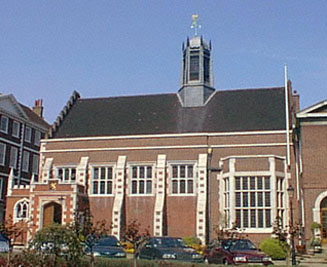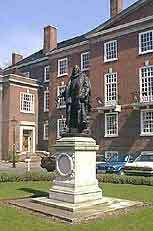|
|

Grays Inn Hall
South Square, Gray's Inn, WC1

A neat little building tucked into a corner of a quiet square, Gray's Inn Hall shows no outward sign of its historical origins or interest. With nothing to indicate its importance, in fact, nothing to draw attention to it at all, the hall stands in cultivated isolation, shielded from the casual passer-by.
The disguise is, of course, intentional. While the hall is open by arrangement, it is normally kept private. Now, as for the past four centuries, the hall is reserved for the members of Gray's Inn, serving their every-day needs in everything from catering to carousal.
In common with its sisters at other Inns of Court, Gray's Inn Hall is central to an ancient legal institution. Although its foundation year is uncertain, records prove that Gray's Inn existed before 1388. The land occupied by Gray's Inn had been owned by Sir Reginald De Grey, Chief Justice of Chester and Constable and Sheriff of Nottingham in the reign of Edward I (1239-1307) and it is likely that a society of lawyers settled here permanently during his lifetime.
As an emerging professional body, the lawyers of Gray's Inn must have had a meeting place although there is no evidence of a purpose-built hall before 1545. The building then on the present site was reconstructed between 1556 and 1560 and this survived until the last war when bombing destroyed all but the exterior walls as well as most of the buildings in the surrounding square.
All was not lost, despite the Blitz. By a stroke of fortune, the hall's exceptional wooden screen had just been dismantled for removal when the worst of the bombing hit. Unable to contain the resulting blaze, firemen braved falling timbers and molten lead showering down from the roof to drag the screen to safety. Almost all of the sections were rescued and when the hall was restored the screen, a beautifully carved 16th century piece thought to have come from a flagship in the Spanish Armada, was put back in place.
Another feature of the hall to survive the war was the majority of the stained glass. Set into windows that were removed in the early 1940's, the different panes bear the arms of former members of the Inn dating back to 1462. One of particular interest, in the centre of the North oriel window, shows the family crest of General Monck, Duke of Albermarle and the man who led King Charles II's army into London at the Restoration. The South oriel window was a gift from the American Bar Association when the hall was rebuilt.
With so much of its inherent character salvaged and the rest - notably the hammer beam roof - painstakingly recrafted, Gray's Inn Hall has successfully retained an atmosphere of age. Substantially the same today as it ever was, the hall seems close to its past, when powerful and dangerous men would meet to discuss the affairs of state.
Names notable for influence and intrigue in Elizabethan times were Lord Burleigh, the Queen's First Minister and principal adviser, Lord Howard of Effingham, the Admiral who dispatched the Spanish Armada and Sir Francis Walshingham, the founder of the Queen's secret service. The third Earl of Southampton, Henry Wriothesley, was also a member of Gray's Inn and it was through his patronage that a certain up-and-coming actor/writer was able to flourish.
That writer was, of course, William Shakespeare and he was just gaining popularity in 1594 when his Comedy of Errors was played in Gray's Inn Hall. The chronicles of the Inn comment stuffily that: 'A company of base and common fellows.. ' gave their performance on December 28 as part of the Christmas revels. The playwright was very probably one of the cast.
Of all the nobles and statesmen of the Tudor era, the one who left a lasting mark on Gray's Inn was the master manipulator, Sir Francis Bacon. Bacon, who courted Queen Elizabeth I's favour but never won it, became Treasurer of Gray's Inn and a prime figure in its development. As well as being acclaimed for his philosophical and scientific works - in particular The Advancement of Learning (1605) and Novum Organum (1620) - Bacon was praised for planning and designing the Inn's famous gardens, better known as the Walks. Records taken in 1597 show it was: 'ordered that the summe of £7. 15s. 4d due to Mr Bacon, for planting of elm-trees in the walkes, be paid next term'. In the next year more trees were ordered at the cost of £60. 6s. 8d.
 Bacon's formal layout was very much admired and by Charles II's reign the Walks had become a highly fashionable place to be seen. The diarist Samuel Pepys was a frequent visitor, relishing the opportunity to eye the ladies and catch up on court gossip. Bacon's formal layout was very much admired and by Charles II's reign the Walks had become a highly fashionable place to be seen. The diarist Samuel Pepys was a frequent visitor, relishing the opportunity to eye the ladies and catch up on court gossip.
Although Francis Bacon was discredited for accepting bribes after becoming Lord Chancellor under James I, his many achievements did not go unrecognised. A statue in his honour has been placed in the pretty square outside Gray's Inn Hall.

Gray's Inn Hall is open by appointment only.
Applications should be made to: The Treasury, South Square, Gray's Inn, London WC1
 Chancery Lane (Central Line) Chancery Lane (Central Line)
Copyright © Jan Collie 2002
Published by permission of the author.
All rights reserved. No reproduction, copy or transmission of this publication may be made without written permission.
|
|